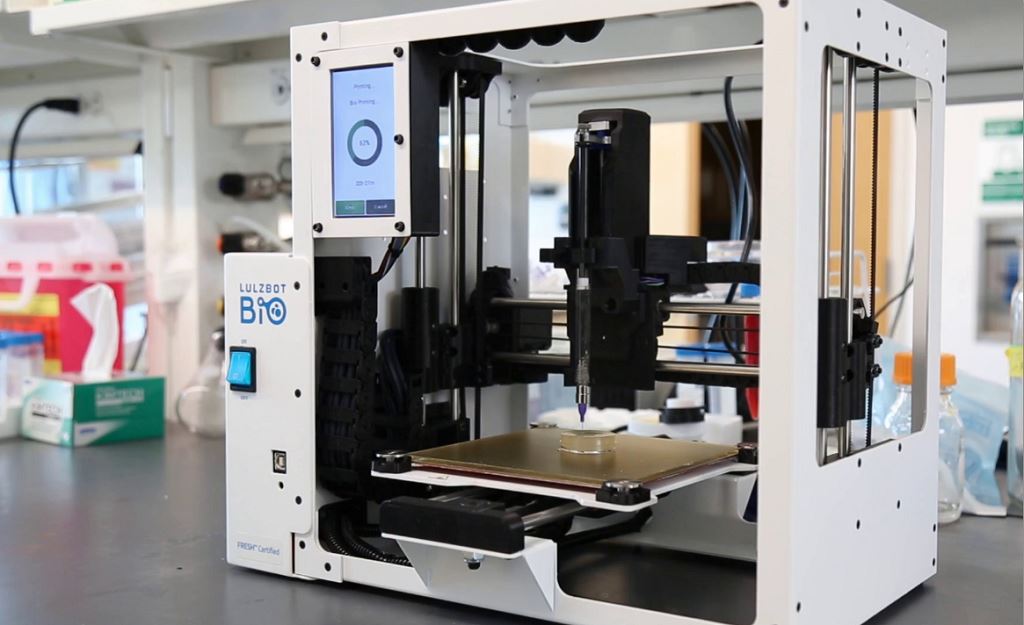![The LulzBot Bio is at home in a lab [Image: Aleph Objects]](https://fabbaloo.com/wp-content/uploads/2020/05/lulzbotbiolab1_img_5eb08f1a306ae.jpg) The LulzBot Bio is at home in a lab [Image: Aleph Objects]
The LulzBot Bio is at home in a lab [Image: Aleph Objects]
Aleph Objects is formally introducing its bioprinter today: the LulzBot Bio.
When we first heard about the potential for a LulzBot bioprinter this summer, it seemed — an unusual move, we’ll say. But here we are a few months later, and the LulzBot Bio is as real as any of the well-known TAZ 3D printers the company has previously rolled out.
LulzBot Bio
![The system has a heated bed [Image: Aleph Objects]](https://fabbaloo.com/wp-content/uploads/2020/05/lulzbotbioheatedbed1_img_5eb08f1a8413b.jpg) The system has a heated bed [Image: Aleph Objects]
The system has a heated bed [Image: Aleph Objects]
The 3D printer has come about through work with FluidForm.
FluidForm’s “FRESH” (Freeform Reversible Embedding of Suspended Hydrogels) 3D printing process, developed with Carnegie Mellon University (CMU), is at the heart of the Bio. And, as with every LulzBot system, this new 3D printer is open source.
The Bio works with unmodified collagen, bioinks — think softer materials. It doesn’t sound like anything too out-of-the-box when it comes to bioprinting, though of course there are some interesting advances.
The collagen the system works with, for example, is unmodified — a previously tricky proposition recently enabled in the FRESH 2.0 method using “thermoreversible support gels to hold soft materials during printing” that are then dissolved. Material profiles are immediately available in Cura LulzBot Edition.
![The LulzBot Bio’s FDF syringe pump system [Image: Aleph Objects]](https://fabbaloo.com/wp-content/uploads/2020/05/lulzbotbiosyringe1_img_5eb08f1ae49b9.jpg)
Rather than the FFF 3D printing of the TAZ line, the Bio 3D printer is an FDF system: Fluid Deposition Fabrication. The Bio works with a syringe pump system to deposit its materials quite precisely.
That the system is open source is important not only to the LulzBot ethos, but to the bioprinter itself. “Open source” isn’t just a nice claim in this case, as researchers benefit quite directly from the ability to tweak their tools to their exact needs.
“For researchers, you don’t know what materials or processes you’ll be using in 6 months, let alone one year from now. You need hardware that can be adjusted quickly and easily, without proprietary restrictions,” said Aleph Objects CEO and President Grant Flaharty.
Validation
The system was proved out earlier this summer with work at CMU to develop 3D printed functional heart tissue. They call it a first, and frankly with so much work ongoing in bioprinting today especially with hearts, that claim is a bit hard anymore to verify — but functional is good, and a hugely important step in validating bioprinting processes to the medical community at large.
More on LulzBot’s functional heart tissue is available here.
“What we’ve shown is that we can print pieces of the heart out of cells and collagen into parts that truly function, like a heart valve or a small beating ventricle. By using MRI data of a human heart, we were able to accurately reproduce patient-specific anatomical structure and 3D bioprint collagen and human heart cells,” said CMU’s Adam Feinberg, professor of biomedical engineering (BME) and materials science & engineering.
Market
Bioprinting is an interesting area of 3D printing, with a variety of processes and producers examining market-ready solutions.
The LulzBot Bio will be available for pre-order soon. The price point was not available as of the time of this writing.
Via LulzBot

